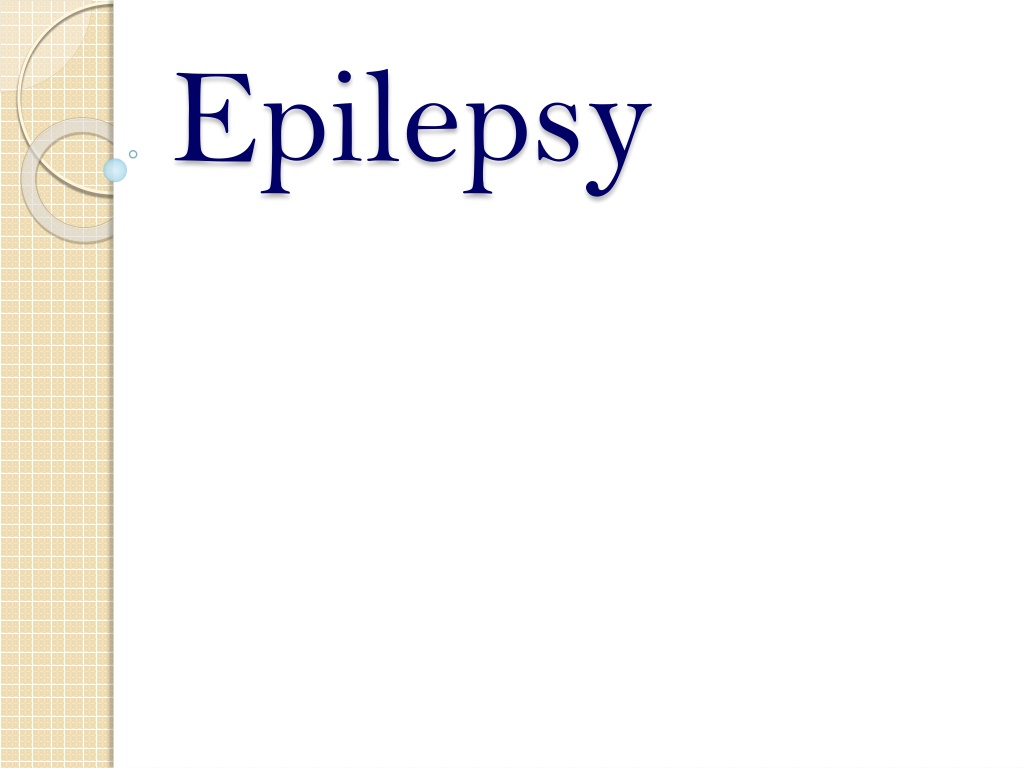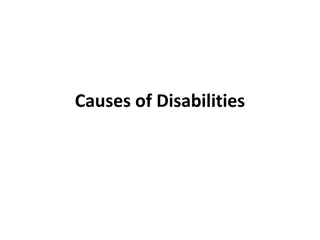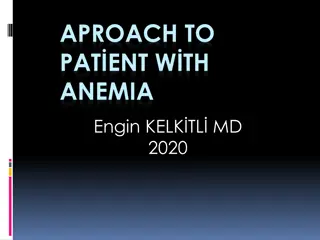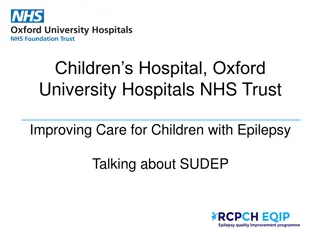Understanding Epilepsy: Causes, Symptoms, and Classification
Epilepsy is a medical disorder characterized by recurrent, unprovoked seizures. Seizures are sudden alterations in perception or behavior caused by abnormal neuronal activity. The incidence of epilepsy is high in early childhood, declines, plateaus, and then rises among the elderly. Seizures can be classified as partial (focal) or generalized, with various subtypes based on clinical manifestations. Focal seizures occur within specific brain regions and may present as simple or complex, with or without impairment of consciousness. Simple focal seizures can involve motor movements, sensory changes, vision disturbances, or psychic symptoms, often serving as a warning sign before a more intense seizure.
Download Presentation

Please find below an Image/Link to download the presentation.
The content on the website is provided AS IS for your information and personal use only. It may not be sold, licensed, or shared on other websites without obtaining consent from the author. Download presentation by click this link. If you encounter any issues during the download, it is possible that the publisher has removed the file from their server.
E N D
Presentation Transcript
Definitions Seizure: Is a sudden involuntary alteration in perception or behavior caused by an abnormal synchronized discharge of cortical neurons. note; a seizure is a symptom and not a disease. Epilepsy: is a medical disorder marked by recurrent, unprovoked seizures. reactive seizures: Are seizures resulting from a temporary and reversible brain insult (such as severe hypoglycemia, drug intoxication); and these seizers, do not meet criteria for a diagnosis of epilepsy.
Epidemiology One in 26 people is at risk of experiencing a single epileptic seizure in the course of their life. The lifetime risk of developing epilepsy is 3.2%. Over half of the 50 million people with epilepsy worldwide are estimated to live in Asia.
The incidence of epilepsy is high in early childhood. It then declines, plateaus from age 15 65 years, and then progressively rises among the elderly to surpass levels seen in childhood
Seizure Classification There are several classifications for types of epilepsy, which are based on clinical seizure types and/or EEG findings. Seizures are classified as partial (focal) or generalized seizures.
Focal Seizures focal seizures occur within discrete regions of the brain. If consciousness is fully preserved during the seizure, the clinical manifestations are considered simple and the seizure is termed a simple focal seizure. If consciousness is impaired, the symptoms are more complex and the seizure is termed a complex focal seizure. Additional subgroup comprises those seizures that begin as focal seizures and then spread diffusely throughout the cortex, i.e. focal seizures with secondary generalization.
Simple focal Seizures Could be motor, as involuntary movements of the contralateral hand. These movements are typically clonic,but pure tonic posturing may be seen as well. Simple focal seizures may also manifest as changes in somatic sensation (e.g., paresthesias), vision (flashing lights), equilibrium (sensation of falling or vertigo). Simple focal seizures arising from the temporal or frontal cortex may also cause alterations in hearing, olfaction, or psychic symptoms. This includes the sensation of unusual, intense odors (e.g., burning rubber or kerosene) or odd internal feelings such as fear, d j vu, or illusions that objects are growing smaller (micropsia) or larger (macropsia). When such symptoms precede a complex focal or secondarily generalized seizure, these simple focal seizures serve as a warning, or aura.
Complex focal Seizures Complex focal seizures are characterized by focal seizure accompanied by impairment of consciousness. The patient is unable to respond to external stimuli during the seizure and has impaired recollection or awareness of the ictal phase. The seizures frequently preceded with an aura. The start of the ictal phase is often a sudden behavioral arrest or motionless stare usually accompanied by automatisms, which are involuntary, automatic behaviors such as chewing, lip smacking, swallowing, or "picking" movements of the hands.
A typical complex focal seizure lasts about 60-90 seconds and is followed confusion. However, asthenia, and fatigue may last for a few days. by brief postictal weakness, generalized Complex focal seizures of frontal-lobe origin may feature bizarre motor behaviors such as bicycling or a fencing posture. These seizures have more prominent motor features than those of complex focal seizures of temporal-lobe onset.
focal Seizures with Secondary Generalization focal seizures can spread to involve both cerebral hemispheres and produce a generalized seizure, usually of the tonic-clonic variety. It is usually difficult to distinguished from a primary generalized tonic-clonic seizure distinguishing between these two entities (by carful history and EEG) is extremely important, as there may be substantial differences in the evaluation and treatment of focal versus generalized seizure disorders. ,on the other hand
Generalized Seizures Generalized seizures involve both hemispheres at the onset of the seizure. The most common types are : primarily generalized tonic clonic (grand mal) seizures, absence (petit mal), atonic myoclonic siezures.
Generalized, Tonic-ClonicSeizures (Grand Mal) It is the most common seizure type, and It consist of: 1. Tonic phase: started suddenly by losing consciousness with tonic contraction of all muscles for 10-30 seconds ,producing extension of back and neck. Tonic contraction of the respiratory muscles produce (cry or moan ) and cyanosis, and contraction of masticatory muscles may cause tongue biting . 2. Clonic phase : alternating muscle contraction and relaxation leading to symmetrical limb jerking that persist for 30-60 seconds.Ventilatory effort return and cyanosis clears.The mouth may froth with saliva, and sphincteric relaxation may produce urinary incontinence.With time jerking become less frequent, until all muscles are flaccid .
3. Phase of coma. After the convulsive movements stop, the patient is in coma.The period of time that the patient remains in coma relates to the duration of the previous tonic and clonic phases. 4.There follows a state of confusion, headache, restlessness and drowsiness before final recovery. This may last for hours.
AbsenceSeizures(PetitMal) Absence seizures usually begin in childhood (ages 4 8) or early adolescence, and they are characterized by sudden, brief episodes of impaired consciousness (lapses of consciousness) with no aura or postictal confusion. They typically last less than 20 seconds (but can occur hundreds of times per day) and are accompanied by few or no automatisms. Of the automatisms that develop, the facial ones are most common, with repetitive blinking or chewing occur most often.
frequently Hyperventilation or photic stimulation precipitates these seizures. Since the clinical signs of the seizures are subtle, especially to new parents, it is not surprising that the first clue to absence epilepsy is often unexplained "daydreaming" and a decline in school performance recognized by a teacher. Patients usually have no other neurologic problems and respond well to treatment with specific anticonvulsants.
AtonicSeizures Atonic seizures drop attacks are characterized by sudden loss of postural muscle tone lasting 1 2 s. Consciousness is briefly impaired, but there is usually no postictal confusion. A very brief seizure may cause only a quick head drop or nodding movement, while a longer seizure will cause the patient to collapse. Myoclonic Seizures Myoclonus is a sudden and brief muscle contraction that may involve one part of the body or the entire body. A normal, common physiologic form of myoclonus is the sudden jerking movement observed while falling asleep. Pathologic myoclonus is most commonly seen in association degenerative CNS diseases, or anoxic brain injury with metabolic disorders,
DIAGNOSIS Epilepsy is a difficult condition to diagnose, and Certainty of diagnosis depends mainly on the history taking from the patient and witnesses. One has to go through the precise details of how the patient felt before, during (if conscious) and after the attack, and also obtain a clear description of how the patient behaved during each stage from a witness.
Questions that help to clarify the type of seizure include the following: Was any warning noted before the seizure? If so, what kind of warning occurred? What did the patient do during the seizure? Was the patient able to relate to the environment during the seizure and/or does the patient have recollection of the seizure? How did the patient feel after the seizure? How long did it take for the patient to get back to baseline condition? How long did the seizure last? How frequently do the seizures occur? Was the attacks similar (stereotyped). Is anything known to precipitate the seizures? Has the patient shown any response to therapy for the seizures?
One out of every 5 patients referred to an epilepsy center with a diagnosis of epilepsy does not suffer from epilepsy. Syncope (eg, cardiac arrhythmia, vasovagal syncope, dysautonomia). Metabolic conditions (eg, hypoglycemia, hyponatremia). Migraine (eg, migrainous aura, migraine equivalent) Vascular conditions (eg, transient ischemic attacks) Sleep disorders (eg, cataplexy, narcolepsy, night terror) Movement disorders (eg, paroxysmal dyskinesia) Gastrointestinal conditions (eg, esophageal reflux in neonates and infants) Psychiatric conditions (eg, conversion, panic attacks, breath-holding spells, malingering, secondary gain)
Pseudoseizures(Psychogenic Seizures): Thrusting nonsynchronous movements episodes tend to last longer lacks stereotypy interictal EEG is persistently normal. Transient Ischemic Attacks: may be difficult to differentiate from Focal seizures but are usually ; Longer. Less frequent. And cause negative rather than positive symptoms. Syncope :
Diagnostic Considerations Physical examination helps in the diagnosis of specific epileptic syndromes that cause abnormal findings, such as dermatologic abnormalities (eg, neurocutaneous syndromes such as Sturge- Weber, tuberous sclerosis, and others). The diagnosis of seizures is based on the patient s clinical history. The history as related by a witness is of high importance, because many types of seizures are associated with impairment of consciousness, and patients are unaware of their occurrence. The clinical diagnosis can be confirmed by abnormalities on the interictal electroencephalogram (EEG). However, these abnormalities can be present in otherwise healthy individuals, and their absence does not exclude the diagnosis of epilepsy.
Prolactin Study Historically, prolactin levels obtained shortly after a seizure (within 20 min) have been used to assess the etiology (epileptic or nonepileptic) of a spell. levels are typically elevated 3- or 4-fold, and elevations are more likely to occur with generalized tonic-clonic seizures than with other seizure types. However, not only has the considerable variability of prolactin levels precluded routine clinical use of such testing, but a baseline prolactin level is often obtained the next day at the same time as when the seizure first occurred, which makes the testing more cumbersome. The AAN recommends serum prolactin assays, measured in the appropriate clinical setting at 10-20 minutes after a suspected event as a useful adjunct for differentiating generalized tonic-clonic or complex focal seizure from psychogenic nonepileptic seizure in adults and older children.
Video-EEG monitoring is the standard test for: classifying the type of seizure. diagnose pseudoseizures . optimize pharmacologic treatment and for presurgical workup. Serum levels of anticonvulsant determine baseline levels. potential toxicity. lack of efficacy. treatment noncompliance.
Brain imaging especially with abnormal examination, focal seizure ,or onset of seizures after 25 years of age . CSF examination in patients with obtundation or in patients in whom meningitis or encephalitis is suspected Blood tests FBS ,serum electrolytes, serum calcium, CBC, RFT, LFT.
Management when the diagnosis of epilepsy is made ,the patient should be warned against working around moving machinery, at heights and reminded of the risk of swimming alone. Driving should be ceased for 6-12 months after the last seizure.
Therapy should be directed toward the cause of seizure ,if known. For example seizures associated with metabolic or systemic disorders are usually not responding to anticonvulsant drugs, but cease by correction of underlying abnormality. And acute withdrawal of alcohol or other sedative drugs produce self-limiting seizures that require no anticonvulsant drug therapy. On the other hand idiopathic epilepsy is treated with anticonvulsant drug therapy . Standard of care for a single, unprovoked seizure is avoidance of typical precipitants (eg, alcohol, sleep deprivation). No anticonvulsants are recommended unless the patient has risk factors for recurrence.
Anticonvulsant drug therapy There are five key principles for management: Establish the diagnosis of epilepsy before starting drug therapy. 1. Choose the right drug for the seizure type 2. Start at low dose ,gradually increasing the dose until effective control of seizure is achieved or side-effects develop. 3. Evaluate one drug each time : In most cases ,seizures can be controlled with a single drug .Therefore beginning therapy with multiple drugs may expose patients to increase drug toxicity without added therapeutic benefit. 4. 5. If first drug fail or side-effects develop, start second line drug whilst gradually withdrawing first.
Withdrawing anticonvulsant therapy Withdrawing of anticonvulsant drugs may be considered only when we have the following : Complete control of seizures for 2-5 years. Normal neurological examination. Normal EEG. Withdrawing should be undertaken slowly, reducing the dose gradually over 6-12 months, and if seizures reoccurs the prior medication should be reinstituted at the same effective dose.
Refractory epilepsy drug resistant epilepsy ( intractable epilepsy) may be defined as failure of adequate trials of two tolerated and appropriately chosen and used AED schedules monotherapies or in combination) to achieve sustained seizure freedom. (whether as
Nonpharmacologic Management Ketogenic diet and modified Atkins diet The ketogenic diet, which relies heavily on the use of fat, has a role in the treatment of children with severe epilepsy. ketogenic diet is difficult to maintain; less than 10% of patients continue the diet after a year. Preliminary studies of a modified Atkins diet have also been performed in adults. Vagal nerve stimulation VNS is a palliative technique that involves surgical implantation of a stimulating device. VNS is currently indicated for patients older than 12 years with medically intractable partial seizures who are not candidates for potentially curative surgical resections.
Implantable neurostimulator The NeuroPace RNS System, a device that is implanted into the cranium, senses and records electrocorticographic patterns and delivers short trains of current pulses to interrupt ictal discharges in the brain. this device was safe and effective in patients with partial-onset epilepsy in whom other antiepileptic treatment approaches have failed . Lobectomy and Lesionectomy Several curative surgeries are possible, including lobectomy and lesionectomy. In general, the epileptogenic zone must be mapped by using video-electroencephalographic (video-EEG) monitoring and, in some patients, with intracranial electrodes.
Benign Febrile Convulsion Benign febrile convulsions are seizures that occur in 2 4% of children aging 3months to 5years,usually during the first day of febrile illness, and in the absence of CNS infection. There may be a family history of febrile convulsion or other types of seizures . It usually last less than 10 -15 minutes and lack focal features .Approximately tow third of patients have a single seizure, and fewer than one tenth have more than three. The probability of developing a chronic seizure disorder is about 2-6% and is highest in patient with: Prolonged , focal or multiple seizure. Abnormal neurological examination. Family history of non-febrile seizure. Because febrile convulsion are usually self limited, treatment is often unnecessary, prolonged convulsions can be treated with diazepam 0.3mg/kg oral, im or iv or 0.6 mg/kg rectally. Long term administration of Phenobarbital is rarely indicated.
Status Epilepticus Status epilepticus is defined as seizures that continue for (15 30) minute without ceasing spontaneously, or which recur so frequently that full consciousness is not restored between attacks . Status epilepticus has numerous subtypes, including generalized convulsive status epilepticus (GCSE), and nonconvulsive status epilepticus GCSE is an emergency and must be treated immediately. The most common causes of GCSE are: anticonvulsant withdrawal or noncompliance. metabolic disturbances. drug toxicity. CNS infection. CNS tumors. refractory epilepsy and head trauma.
Complications of ConvulsiveStatus Epilepticus Respiratory Hypoxia Hypercapnia Aspiration pneumonia Cardiovascular Hypotension Tachycardia Cardiac arrhythmia Renal Myoglobinuria Rhabdomyolysis Acute tubular necrosis Autonomic Hyperthermia Impaired cerebral autoregulation Metabolic Lactic acidosis Hypoglycemia Electrolyte disturbances Neurologic Excitotoxic neuronal damage Increased intracranial pressure Decreased cerebral perfusion Cerebral edema Cerebrospinal fluid pleocytosis
Management of status epilepticus
Step 1 (0 to 5 minutes) Give oxygen.Assess airway and apply pulse oximeter. Perform venipuncture and secure IV access. Send blood for : liver function tests, calcium, magnesium, phosphate, complete blood count, toxicology screens, and antiepileptic drug levels. Check finger-stick glucose. Start a normal saline drip. Step 2 (6 to 10 minutes) Administer thiamine and dextrose (unless normoglycemic). 100-mg thiamine IV plus 50 mL of 50% dextrose IV. Give IV lorazepam at 0.1 mg/kg by IV push at a rate no greater than 2 mg/min. (Repeat if no response after 5 min.)
Step 3 (11 to 30 minutes) Give IV fosphenytoin (20 mg /kg), no faster than 150 mg /min or IV phenytoin (20 mg/kg)by slow IV push no faster than 50 mg/min. (Phenytoin is incompatible with glucose-containing Solutions). If seizures persist, give additional IV fosphenytoin or phenytoin to a maximum total dose 30 mg/kg. Step 4 (31 to 50 minutes) If seizures persist, patient will likely need to be intubated; and consider the following: IV phenobarbital 20 mg/kg slow push (60 mg/min). If seizure persist: IV pentobarbital 10 mg/kg (60 mg/min). If seizure persist: General anasthesia with pentobarbital). ( propofol, midazolam, or
Step 5 Order urgent EEG. If seizures persist, maintain continuous IV infusion of pentobarbital, midazolam, or propofol and titrate dose to desired level of EEG suppression.























